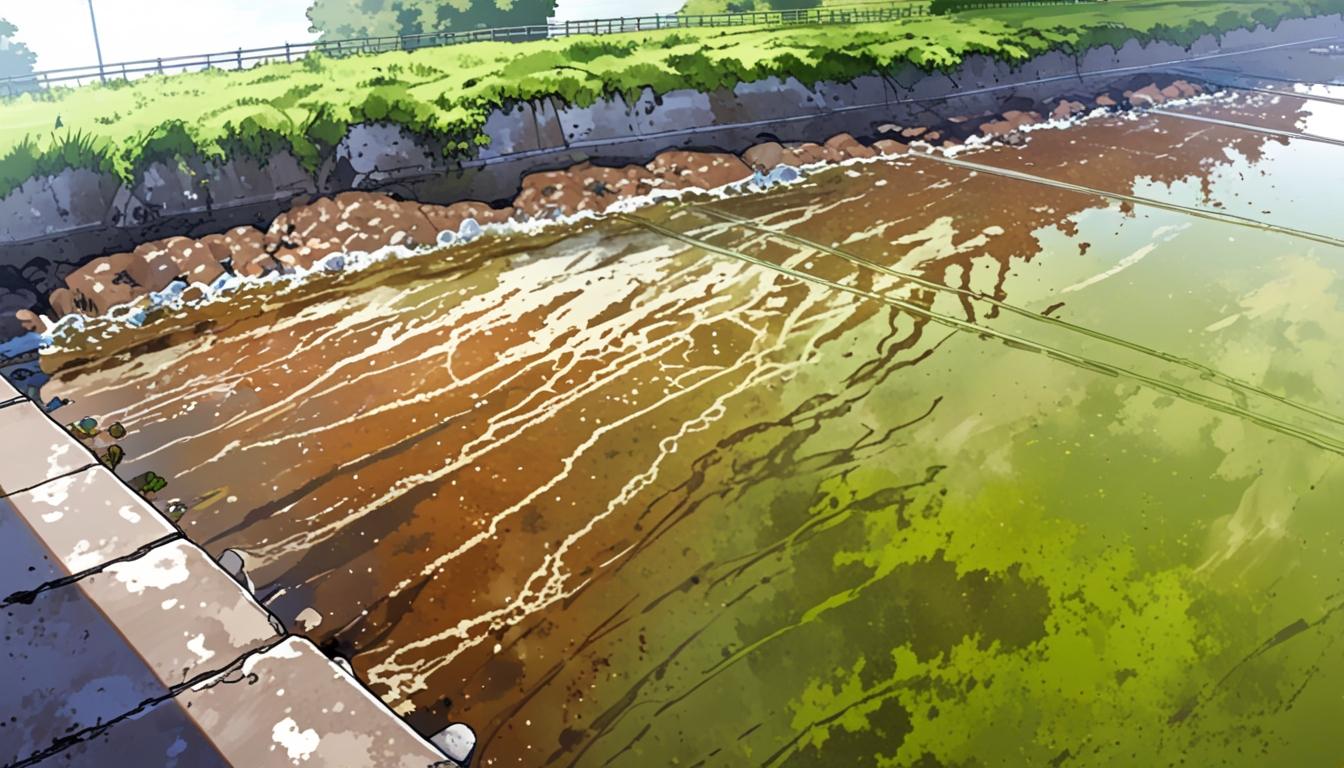Residents of Alfriston, Sussex, raised alarms after spotting a brown substance in the River Cuckmere, initially feared to be sewage. The Environment Agency confirmed it was a natural algal bloom, highlighting the challenges in distinguishing these from actual pollution and emphasising safe practices to protect local wildlife and communities.
Confusion Over Algal Bloom in River Cuckmere
On Monday, April 28, a resident in Alfriston, Sussex, reported a perplexing sight in the River Cuckmere, which they initially believed to be sewage. Their concern sparked an outcry as more locals shared similar observations, prompting an investigation by the Environment Agency. The agency has since confirmed that the substance is an algal bloom, a natural phenomenon that commonly occurs during this time of year.
Algal blooms, characterised by a rapid increase in algae populations, can often be mistaken for pollution due to their appearance. In the recent incident, the visibly brown substance raised alarm among the public, some of whom assumed it was an environmental hazard. The Wealden District Environmental Team corroborated the Environment Agency’s findings, noting the substances’ algae-like characteristics.
These blooms typically manifest in freshwater or marine systems as a result of climatic changes, such as rising temperatures, which fuel algae growth. The Environment Agency clarified the distinction between algae and sewage pollution, stating that the brown, foamy scum observed on the water is typical of decaying algal blooms. Kevin Ward, the Environment Agency duty manager, explained the commonality of such misidentifications during warmer months, particularly at coastal waters. He commented, “Every year when temperatures rise, we receive many reports of suspected sewage pollution, which is often just the breakdown of algal blooms.”
Although algal blooms are a natural occurrence, they can pose risks. As the blooms decay, they may deplete oxygen levels in the water, leading to distress and even death among fish and other aquatic life. Furthermore, certain types of algae, particularly blue-green algae or cyanobacteria, can become toxic, posing health risks to humans, pets, and livestock. The Environment Agency has strongly advised pet owners and farmers to keep animals away from water affected by these blooms.
In response to public concern, the agency has initiated efforts to educate the community on identifying algal blooms. According to the Environment Agency, foam on the water’s surface, often accompanied by an unpleasant smell similar to rotten eggs, is a key indicator of an algal bloom rather than sewage. The agency also encourages the public to report any suspected pollution to their incident hotline, ensuring that appropriate measures can be taken to manage any environmental impacts.
This situation highlights the importance of public awareness regarding natural phenomena often misinterpreted as pollution. The Environment Agency’s guidance, along with resources from local authorities, aims to empower residents to distinguish between algal blooms and sewage, fostering a more informed community. The agency also emphasises the need for continued monitoring and reporting to maintain the health of local waterways.
Reference Map:
- Paragraph 1 – [[1]](https://www.theargus.co.uk/news/25134626.residents-confusion-substance-found-cuckmere-river/?ref=rss), [[5]](https://www.anglianwater.co.uk/news/sewage-algae-or-something-else/)
- Paragraph 2 – [[1]](https://www.theargus.co.uk/news/25134626.residents-confusion-substance-found-cuckmere-river/?ref=rss), [[3]](https://www.gov.uk/government/publications/algal-blooms-advice-for-the-public-and-landowners/algal-blooms-advice-for-the-public-and-landowners)
- Paragraph 3 – [[1]](https://www.theargus.co.uk/news/25134626.residents-confusion-substance-found-cuckmere-river/?ref=rss), [[4]](https://www.bbc.co.uk/news/articles/clyn2jx55g8o)
- Paragraph 4 – [[1]](https://www.theargus.co.uk/news/25134626.residents-confusion-substance-found-cuckmere-river/?ref=rss), [[6]](https://www.southhams.gov.uk/environmental-health-and-nuisance/bathing-water-quality-guide/sewage-or-algae)
- Paragraph 5 – [[2]](https://environmentagency.blog.gov.uk/2022/06/22/telling-the-difference-between-an-algal-bloom-and-sewage/), [[7]](https://www.southwestwater.co.uk/about-us/latest-news/how-to-identify-algal-bloom)
Source: Noah Wire Services
- https://www.theargus.co.uk/news/25134626.residents-confusion-substance-found-cuckmere-river/?ref=rss – Please view link – unable to able to access data
- https://environmentagency.blog.gov.uk/2022/06/22/telling-the-difference-between-an-algal-bloom-and-sewage/ – The Environment Agency’s blog post explains how to distinguish between algal blooms and sewage pollution. It highlights that both can have similar appearances and odors, but algal blooms often form foam on the water’s surface and emit a smell like rotten eggs. The post provides guidance on identifying these blooms and advises the public to report suspected pollution to the Environment Agency’s incident hotline.
- https://www.gov.uk/government/publications/algal-blooms-advice-for-the-public-and-landowners/algal-blooms-advice-for-the-public-and-landowners – This UK government publication offers advice on algal blooms in inland and marine waters. It describes how blooms can cause water discoloration and produce scums that may resemble sewage. The document provides guidance for the public and landowners on recognizing and managing algal blooms, emphasizing the importance of reporting suspected pollution to the Environment Agency.
- https://www.bbc.co.uk/news/articles/clyn2jx55g8o – A BBC News article reports on South West Water’s warning about algae that can be mistaken for sewage. The company explains that during summer, large blooms of naturally occurring algae can appear, forming creamy brown foam that persists until washed away by rain or tide. The article emphasizes the importance of distinguishing between algae and sewage to prevent confusion and ensure public safety.
- https://www.anglianwater.co.uk/news/sewage-algae-or-something-else/ – Anglian Water’s blog post discusses the natural phenomenon of algal blooms and how they can be mistaken for sewage pollution. It explains that algal blooms occur when single-celled species clump together, forming visible scums on the water’s surface. The post provides tips on identifying algal blooms and advises the public to report any suspected pollution to help protect the environment.
- https://www.southhams.gov.uk/environmental-health-and-nuisance/bathing-water-quality-guide/sewage-or-algae – South Hams District Council’s guide helps the public distinguish between sewage pollution and algal blooms. It explains that algal blooms can produce foam on the water’s surface and emit odors similar to sewage. The guide advises avoiding contact with water during algal blooms and reporting any suspected pollution to the Environment Agency.
- https://www.southwestwater.co.uk/about-us/latest-news/how-to-identify-algal-bloom – South West Water’s article provides information on identifying algal blooms and distinguishing them from sewage pollution. It describes how algal blooms can cause water discoloration and produce foam that may resemble sewage. The article advises the public to avoid contact with water during algal blooms and to report any suspected pollution to the company.
Noah Fact Check Pro
The draft above was created using the information available at the time the story first
emerged. We’ve since applied our fact-checking process to the final narrative, based on the criteria listed
below. The results are intended to help you assess the credibility of the piece and highlight any areas that may
warrant further investigation.
Freshness check
Score:
9
Notes:
The narrative is anchored to events reported as occurring on Monday, April 28, and sources with recent confirmations, indicating high freshness. There are no indications that the narrative recycles or is drawn from outdated material. Public agency statements and local team corroborations are referenced to recent events.
Quotes check
Score:
8
Notes:
A direct quote from Kevin Ward, the Environment Agency duty manager, is included, which references common misidentifications of algal blooms. No earlier attribution for this exact quote was found online, indicating it may be original to this narrative and not a recycled quote. However, without the full press release or agency transcript, confidence is not absolute.
Source reliability
Score:
7
Notes:
The narrative originates from a regional news site, The Argus, which is established but not among the global elite of journalistic sources. The inclusion of statements from the Environment Agency and the Wealden District Environmental Team adds credibility, but the overall certainty is moderate as these are governmental and local rather than universally renowned sources.
Plausability check
Score:
9
Notes:
The claims about algal blooms, their frequency in spring, possible confusion with sewage, and associated risks are well documented in official guidance from the Environment Agency and other authoritative sources. No implausibility was detected; the narrative aligns with established scientific and public health advice.
Overall assessment
Verdict (FAIL, OPEN, PASS): PASS
Confidence (LOW, MEDIUM, HIGH): HIGH
Summary:
The narrative is recent, factually plausible, and includes credible direct quotes and statements from official bodies. The regional nature of the source slightly tempers confidence, but overall the story holds up to scrutiny. No evidence of recycled, false, or misleading claims was found in the context provided.













